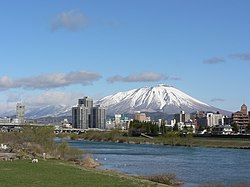Morioka
|
Morioka 盛岡市 |
|||
|---|---|---|---|
| Core city | |||

Morioka and Mount Iwate
|
|||
|
|||
 Map of Iwate Prefecture with Morioka highlighted in pink |
|||
| Coordinates: 39°42′7.5″N 141°09′16.2″E / 39.702083°N 141.154500°ECoordinates: 39°42′7.5″N 141°09′16.2″E / 39.702083°N 141.154500°E | |||
| Country | Japan | ||
| Region | Tōhoku | ||
| Prefecture | Iwate | ||
| Government | |||
| • -Mayor | Hiroaki Tanifuji | ||
| Area | |||
| • Total | 886.47 km2 (342.27 sq mi) | ||
| Population (September 2015) | |||
| • Total | 299,169 | ||
| • Density | 337/km2 (870/sq mi) | ||
| Time zone | Japan Standard Time (UTC+9) | ||
| Symbols | |||
| • Tree | Katsura | ||
| • Flower | Rabbit-ear iris | ||
| • Bird | Wagtail | ||
| Phone number | 019-651-4111 | ||
| Address | 12-2 Uchimaru, Morioka-shi, Iwate-ken 020-8530 | ||
| Website | Official website | ||
Morioka (盛岡市 Morioka-shi?) is the capital city of Iwate Prefecture located in the Tōhoku region of northern Japan. As of September 2015, the city had an estimated population of 299,169 and a population density of 337 persons per km2. The total area was 886.47 square kilometres (342.27 sq mi).
The area of present-day Morioka has been continuously inhabited since the Japanese Paleolithic period. Numerous Jomon, Yayoi and Kofun period tombs and remains have been found. The Emishi inhabited the area into the Heian period. During the Enryaku era of the Heian period, Sakanoue no Tamuramaro, was ordered north to Shiwa Castle in 803 AD, as a military center to extend the domination of the Yamato dynasty over Mutsu Province. The area was later ruled by the Abe clan until their destruction during the Former Nine Years War at the hands of the Minamoto and Kiyohara clans. The Kiyohara were in turn defeated in the Gosannen War and the area came under the control of the Ōshū Fujiwara Clan based in Hiraizumi, to the south of Morioka. After the Ōshū Fujiwara were destroyed by Minamoto no Yoritomo at the start of the Kamakura period, the area was disputed by several samurai clans until the Nanbu clan, based in Sannohe to the north, expanded their territory during the Sengoku period and built Kozukata Castle in 1592.
...
Wikipedia



